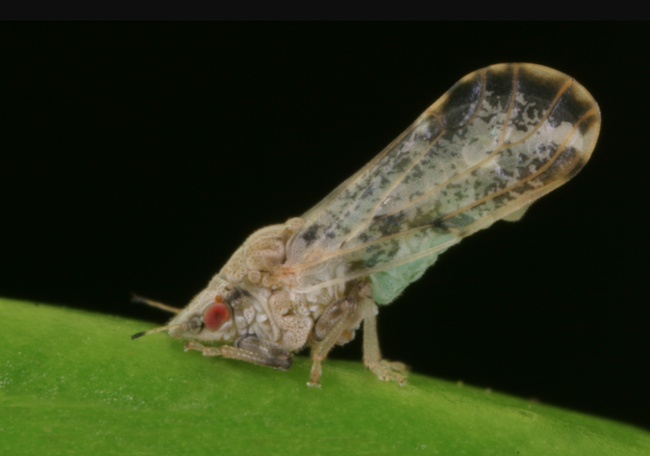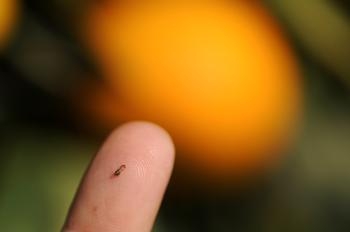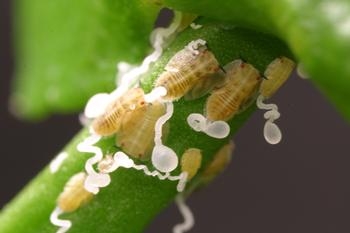Residents urged to check their citrus trees for Asian citrus psyllid
An insect carrying the huanglongbing bacteria, a pathogen that kills citrus trees, has been found on a residential citrus tree in Ventura County, according to the California Citrus Pest & Disease Prevention Program.
“This really is a devastating find,” said Ben Faber, UC Cooperative Extension subtropical crops advisor for Ventura and Santa Barbara counties. “It means that Asian citrus psyllid that is infected with the HLB bacteria is present in the middle of a citrus-growing area that is currently and historically important for lemon production.”
This is the first confirmed case in Ventura County of Asian citrus psyllid testing positive for the bacterium Candidatus Liberibacter asiaticus. The bacterium is associated with huanglongbing, or HLB, also called citrus greening disease. HLB can kill a citrus tree in as few as five years, and there is no known cure or remedy. All commonly grown citrus varieties are susceptible to the pathogen, which means commercial citrus growers should monitor and treat to manage its vector to protect their groves. The additional expenses come at a bad time.
“The disease is a tree killer and it's happening to growers who are already having difficult times with low lemon prices making it difficult for them to stay and continue farming,” Faber said.
The infected Asian citrus psyllid was found in the Santa Paula area, but the UCCE farm advisor asks all Ventura County citrus tree owners to be on the lookout for the tiny, mottled brown insect about the size of an aphid.
“It takes a whole community to address the disease in order to protect all the trees,” Faber said. “If one tree remains, it potentially can infect all the surrounding citrus trees.”
The psyllid takes the bacteria into its body when it feeds on bacteria-infected plants. When a bacteria-carrying psyllid flies to a healthy plant and injects the bacteria into the plant as it feeds, it can spread the disease.
Hamutahl Cohen, UCCE entomology advisor for Ventura County, saw the devastation of HLB on citrus in Florida, where she worked before moving to California.
“After 2005, we saw that HLB spread rapidly across Florida, resulting in tree mortality and increased costs of production,” she said. “Due to HLB, orange yield in Florida decreased about 40%. In California, growers will benefit if the public helps them by monitoring their backyard citrus trees."
As of Sept. 20, HLB had not been detected in any Ventura County citrus trees.
Neil McRoberts, UC Davis professor of plant pathology, urged vigilance, but not panic. “We have long suspected that ACP infected with the pathogen are present in Ventura, the results simply confirm that suspicion.”
The only way to protect citrus trees from the lethal disease is to prevent the spread of the HLB pathogen by controlling psyllid populations and destroying infected trees.
“Not all ACP carry the bacteria, but if one is found, it means either that an infected insect has flown or hitchhiked in,” Faber said. The psyllids can fly pretty far by themselves, but they can move great distances when people move them.
To identify Asian citrus psyllid, see pictures of the psyllid and its life stages on the UC Agriculture and Natural Resources website at http://ucanr.edu/acp and the UC Integrated Pest Management Pest Note at https://ipm.ucanr.edu/PMG/PESTNOTES/pn74155.html. More information is also available at https://californiacitrusthreat.org , a website maintained by the Citrus Pest & Disease Prevention Program, an initiative funded by California citrus growers and administered by the California Department of Food and Agriculture.
Beth Grafton-Cardwell, UC Cooperative Extension citrus entomology specialist emeritus, and Mark Hoddle, UCCE entomology specialist based at UC Riverside, demonstrate how to look for the various stages of the psyllid in the video “Check your citrus trees for Asian citrus psyllid” on YouTube https://www.youtube.com/watch?v=UhqwUQm0zpk.
Report suspected cases of the psyllid or disease to your county agricultural commissioner's office or call the CDFA hotline at 1-800-491-1899.
Commercial growers can get the latest news about ACP at the Citrus Pest & Disease Prevention Program website https://citrusinsider.org.
More information about Asian citrus psyllid can be found in ANR publication 8205 https://escholarship.org/uc/item/8vr1376d, ANR publication 8218 https://escholarship.org/uc/item/48v1v164 and on the U.S. Department of Agriculture website https://www.aphis.usda.gov/aphis/resources/pests-diseases/hungry-pests/the-threat/asian-citrus-psyllid/asian-citrus-psyllid.


